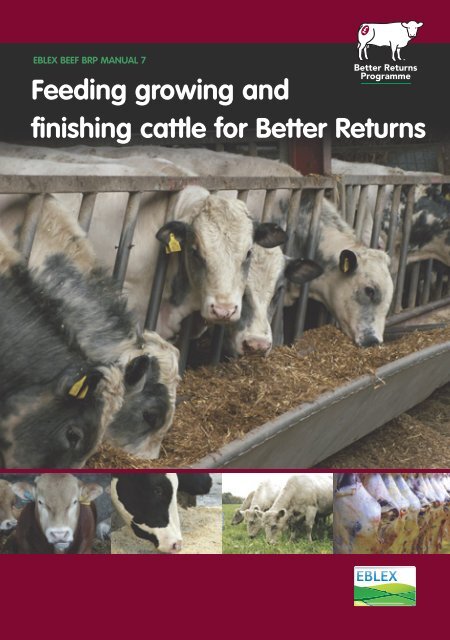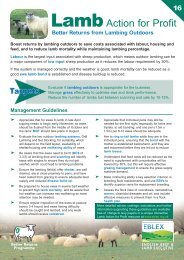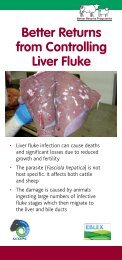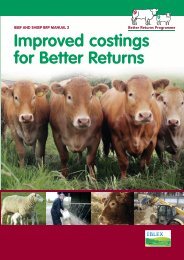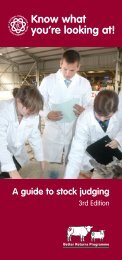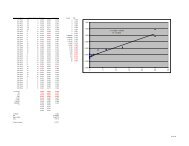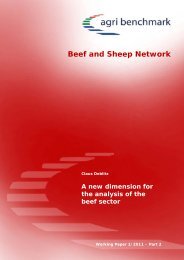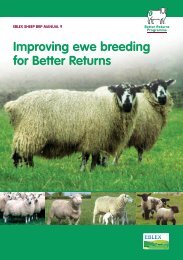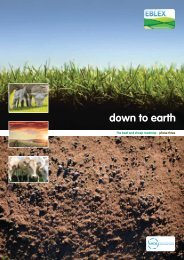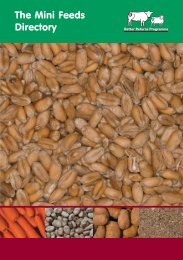Feeding growing and finishing cattle for Better Returns manual - Eblex
Feeding growing and finishing cattle for Better Returns manual - Eblex
Feeding growing and finishing cattle for Better Returns manual - Eblex
You also want an ePaper? Increase the reach of your titles
YUMPU automatically turns print PDFs into web optimized ePapers that Google loves.
EBLEX BEEF BRP MANUAL 7<strong>Feeding</strong> <strong>growing</strong> <strong>and</strong><strong>finishing</strong> <strong>cattle</strong> <strong>for</strong> <strong>Better</strong> <strong>Returns</strong>
The in<strong>for</strong>mation in this book was compiled by: Donald Brown,Keenan Rumans <strong>and</strong> Mary Vickers, EBLEXBRP is grateful to all those who have commented <strong>and</strong> contributedto this production.Edited: Geoff Dodgson, ChamberlainIllustrations: Tebbit DesignEBLEX Beef <strong>Better</strong> <strong>Returns</strong> Programmehas funded the writing <strong>and</strong>publication of this booklet. While theauthors have worked on the bestin<strong>for</strong>mation available to them, neitherthe EBLEX Beef <strong>Better</strong> <strong>Returns</strong>Programme, nor the authors shall inany event be liable <strong>for</strong> any loss, damageor injury howsoever suffered directly orindirectly in relation to the booklet orthe in<strong>for</strong>mation on which it is based.Reference herein to trade names <strong>and</strong>proprietary products <strong>and</strong> serviceswithout stating that they are protecteddoes not imply that they may beregarded as unprotected <strong>and</strong> thus free<strong>for</strong> general use. No endorsement ofnamed products or services is intendednor any criticism implied of otheralternative but unnamed products.For more in<strong>for</strong>mation contact:<strong>Better</strong> <strong>Returns</strong> ProgrammeEBLEX LtdGraphic HouseFerrars RoadHuntingdonPE29 3EETel: 0870 241 8829Fax: 0871 433 6205Email: brp@eblex.org.ukwww.eblex.org.uk/betterreturns© 2008 EBLEX Ltd
ContentsPage 2 Growing <strong>and</strong><strong>finishing</strong> phasesPage 3 <strong>Feeding</strong> <strong>for</strong>growthPage 4 Maximisingdry matter intakePage 5 RationguidelinesPage 6 Making themost of grassPage 7 Growinghoused <strong>cattle</strong>Page 8 Growing to<strong>finishing</strong> the bigchangePage 9 Finishinghoused <strong>cattle</strong>Page 10 Feedconversion efficiencyPage 11 <strong>Feeding</strong> <strong>for</strong>carcase qualityPage 12 Optimisingnutrient balancePage 13 Choosing thesupplementPage 14Supplementing silage<strong>and</strong> strawPage 15 What is thedung telling youPage 16 Top 20 energyfeedsPage 17 Top 10 proteinfeedsGrowing <strong>and</strong> <strong>finishing</strong> <strong>cattle</strong> requires attentionto detail at all stages to be able to matchmarket needs <strong>and</strong> make the best return on yourinvestment. Best returns comes from <strong>cattle</strong> thatare well grown <strong>and</strong> efficiently finished. <strong>Feeding</strong>not only determines animal per<strong>for</strong>mance but alsocontributes to animal health, cost of production<strong>and</strong> there<strong>for</strong>e profit margins.This BRP <strong>manual</strong> will illustrate the importanceof distinguishing between the rearing, <strong>growing</strong><strong>and</strong> <strong>finishing</strong> phase. As well as <strong>for</strong>mulatingrations according to animal requirements tooptimise animal per<strong>for</strong>mance appropriate to thesystem <strong>and</strong> meet market specifications.The role of feeding in determining carcasequality is discussed, along with advice aboutchoosing the best feeds <strong>for</strong> your <strong>cattle</strong> tomeet their nutrient requirements.The <strong>manual</strong> complements our earlier publicationBRP Mini Feeds Directory which providesguidance from conception to market on usingeffective nutrition to achieve better returns ona range of feeds.John CrossChairmanEBLEX Ltd1
Growing <strong>and</strong> <strong>finishing</strong> phases<strong>Feeding</strong> management of beef <strong>cattle</strong> divides into three distinct phases.Each requires different ration specifications.When to change rationWeightTarget weightHeightlarge framemedium framesmall frameRearing Growing Finishingis usually completeby the time a calfweighs 200kg <strong>and</strong>is centred aroundmilk feeding <strong>and</strong>weaning.a period of continuous growth, lasting up to 15 months.Developing height <strong>and</strong> length of body frame is the aimin this period.The length of each phase varies with breed, frame size <strong>and</strong> target market. Native breeds or small framed<strong>cattle</strong> usually require a longer <strong>growing</strong>, but shorter <strong>finishing</strong> period than larger continental <strong>cattle</strong>.<strong>Feeding</strong> management is crucial to meet market specificationKnow your end market; <strong>cattle</strong> finish at a variety of weights, different ages. Target specifications willvary depending on breeding <strong>and</strong> the target market. Here are some examples.Please note there will be variations on the above examples.2a short sharp period ofmaximum weight gain toallow well-grown animalsto maximise meat yield<strong>and</strong> optimise fat cover.HitmarketspecMain market Target age Type Carcase weight ClassificationButchers 16-24 months Heifers, steers 250-320kg R4L or betterSupermarket 16-30 months Heifers, steers 280-380kg R3 or betterManufacturing beef 12-30 months Bulls, heifers, steers 280-400kg -02 or better
<strong>Feeding</strong> to growUnderst<strong>and</strong>ing your stock <strong>and</strong> system will help you feed to exploitgrowth potentialYour choice of beef production system shouldbe based on your available resources.Stock – is determined by:Gender – bull, steer or heifersMature size – small, medium or large framedType – Native or continental.System – is determined by:feed, l<strong>and</strong>, buildings, machinery, labour, finance.The frame size of an animal is a useful guideto its growth potential <strong>and</strong> which feedingsystem it is best suited to. Frame sizedetermines mature liveweight <strong>and</strong> is affectedby breed type <strong>and</strong> breeding within a breed.When assessing frame size in <strong>growing</strong> <strong>cattle</strong>take account of breed, age, weight <strong>and</strong> height.Large-framed animals, tall <strong>for</strong> their age, suitmarkets which target fast daily liveweight gainof over 1kg/head/day.Short–framed animals, short <strong>for</strong> their age,suit markets with slower target daily gain–under 0.8kg/head/day.Medium-framed animals of average height<strong>for</strong> their age are best grown between 0.8 <strong>and</strong>1kg/head/day <strong>and</strong> can be targeted to anumber of markets.Pointers Use the rails in a race to give a guide to frame size.Target height gain/monthAnimal Small frame Medium frame Large frame200kg – 300kg 3cm 4cm 5cm300kg – 400kg 2cm 3cm 4cm400+kg 1cm 2cm 3cm3
Maximising Dry Matter IntakeMaximising dry matter intake is vital to better <strong>growing</strong> <strong>and</strong> <strong>finishing</strong> of <strong>cattle</strong>. Improving animalper<strong>for</strong>mance reduces days to slaughter <strong>and</strong> cuts production costs.It is important to present fresh palatable feed <strong>and</strong> have water available at all times to optimise intake<strong>and</strong> remember the old saying a dry bed is as good as a feed.A well-designed <strong>and</strong> managed feed area can be as important as what is fed.✓✓✓✓✓✗✗✗very smooth, clean surfaceeating surface about 10cm above hoof heightbrisket board, preventing food being pulled under foot, suited to height of <strong>cattle</strong>clean out refused food at least 3 times a weeksite water troughs to avoid feed being splashedpitted concrete that can be rough on the tonguerub marks from neck rail – shows wrong positionstale feed build up•4
Ration guidelinesGrowing animals have a large appetite compared to body weight. Thus they thrive on high levels ofmedium energy <strong>for</strong>age, as long as there is enough degradable protein to ‘fuel’ microbial activity inthe rumen.Growing <strong>cattle</strong> – controlled continuousframe growthDMI = 2.3% bodyweight0.7 –1.3kg/day LWG30 – 60% DM (dry matter)*15 –16% CP (crude protein)10.5 –11.4 MJ/kg DM ME (metabolisable energy)*>40% NDF (neutral detergent fibre)– digestible*12.2 MJ/kg DM ME (metabolisable energy)*>25% NDF (neutral detergent fibre)– digestible*6– 8 % long fibre*33% starch <strong>and</strong> sugar*0.6% calciumGrowing rations should be high in both structuralfibre eg straw <strong>and</strong> digestive fibre eg sugar beetpulp, high in protein, high in minerals <strong>and</strong>vitamins <strong>and</strong> with a moderate energy density.High levels of starch are not recommended inthis period as this can lead to unwanted fatdeposition, especially in small-medium framed,‘easy fleshed’ <strong>cattle</strong>. Some ‘easy fleshed’ <strong>growing</strong><strong>cattle</strong> can stay on this ration till finish to avoidgetting over fat while underweight.Finishing <strong>cattle</strong> are often heavier than <strong>growing</strong><strong>cattle</strong>, with a reduced appetite in relation to bodyweight. Rapid liveweight gain requires feedinghigh energy cereal based feeds. High starch levelscan promote fast weight gains <strong>and</strong> more efficientfeed conversion particularly in the larger framed,more difficult to flesh animals.The key to profitable <strong>finishing</strong> is feed conversionefficiency (FCE), obtained by maintaining highdry matter intakes <strong>and</strong> live weight gains.Adequate quantities of structural fibre(0.5– 1.5kg straw/head/day) is essential.Animals that spend long periods lying downchewing the cud, are an indication of efficientfeed utilisation <strong>and</strong> good rumen health.* expressed relative to DM5
Making the most of grassGrazingGrazed grass is potentially the cheapest feed available. To achieve the best potential growth consider:stocking rates, sward, grazing quality <strong>and</strong> quantity.The use of modern grass varieties along with appropriate types of clover in the sward can bring bigyield benefits as well as reducing nitrogen fertiliser requirements. Target gains at grass depend ontype of stock, available grazing type <strong>and</strong> length of grazing season. Large-framed <strong>cattle</strong> turned outat 250-300kg onto good leys with a long grazing season can gain 200kg. Small-framed <strong>cattle</strong> onmarginal grazing may gain just half this weight.When grazing is insufficient supplementation will be needed:Concentrate supplementationHigh quality <strong>for</strong>age-based buffer ration• low levels maintain contact with stock • maintains growth rates• higher levels help maintain growth rates • reduces grazing time• does not reduce grazing time • allows grass regrowthFinishing <strong>cattle</strong> on grassHigh levels of grass quality <strong>and</strong> quantity must bemaintained <strong>for</strong> as long as possible to take ‘easyfleshed’ <strong>cattle</strong> through to finish. Bigger framed<strong>cattle</strong> struggle to achieve a good finish onpasture alone in summer <strong>and</strong> autumn. Finisherscan be kept out on full ad-lib <strong>finishing</strong> feed aslong as ground is dry enough to avoid poaching<strong>and</strong> there is a dry area to lie down.Keep lot sizes small <strong>and</strong> move bunkers, troughs<strong>and</strong> feed trailers regularly to avoid poaching .For <strong>finishing</strong> <strong>cattle</strong>, high quality grass silagecan be a digestible fibre source replacing sugarbeet pulp, maize gluten, etc. However, fed athigh levels alongside high starch feeds can resultin loose dung.Alternatively, silage can be made very maturewith a long chop length. Fed in small quantitiesit offers a structural fibre source to keep therumen healthy when high levels of concentratesare fed.SilageFor <strong>growing</strong> <strong>cattle</strong> grass should not beallowed to mature beyond 50% ear emergenceat cutting. <strong>Feeding</strong> silage with straw delaysprogress through the rumen allowing improveddigestion.6
Growing housed <strong>cattle</strong>Grower rations are mainly <strong>for</strong>age-based (silage, whole crop, straw <strong>and</strong> combinations of these). Thesecan be supplemented at least once a day with dry or moist feeds to add energy, protein, minerals <strong>and</strong>vitamins. Rations can be <strong>for</strong>mulated with a wide range of home-grown <strong>and</strong> bought-in feeds. The mostlikely scenario <strong>for</strong> a winter ration would be grass silage plus a blend. It is important that silage ispalatable <strong>and</strong> consistent quality, it also helps if it contains reasonable levels of protein. Generally,only wholecrop legume silages can be fed without protein supplementation. The <strong>for</strong>mulation <strong>and</strong>quantity of supplement depends on silage analysis <strong>and</strong> intake. Adding straw slows down the rate ofpassage of silage <strong>and</strong> promotes cud chewing.<strong>Feeding</strong> <strong>for</strong> <strong>growing</strong> – starting the processCattle already on the farmIntroduce suckler calves to creep feeding as <strong>and</strong>when required depending on target growth rates,available milk <strong>and</strong> grazing. Begin at least 4 weeksbe<strong>for</strong>e weaning to minimise ‘weaning check’.Creep feed should be palatable, dust-free <strong>and</strong>contain high levels of digestible fibre.Creep feed can include trace elements <strong>and</strong>vitamins to boost immune status be<strong>for</strong>erespiratory disease challenges in early winter.Typical creep ration:14 –16% crude protein in DM11–12 MJ/kg DM ME35% NDF (neutral detergent fibre) - digestibleTarget gain: 0.8 – 1.3kg/day LWGBought-in <strong>cattle</strong>Cattle, tired after a journey, should be kept awayfrom other stock in a draft-free, well bedded pen,with plenty of space, good access to palatable<strong>for</strong>age-based feed with long fibre <strong>and</strong> cleanwater.After 12-18 hours rest:• check ear tags <strong>and</strong> weigh each animal• health check in accordance with farm’shealth plan• if necessary, treat <strong>and</strong> isolate• vaccinate.Then group animals by weight <strong>and</strong> type.Gradually introduce them to their new rationbe<strong>for</strong>e moving to new accommodation.7
Growing to <strong>finishing</strong> – the big changeTiming is the key to changing successfully from the <strong>growing</strong> to the <strong>finishing</strong> ration.Targets Days on <strong>finishing</strong> ration DLWG Total LW gainLarge framed 80–100 1.5kg 120-150kgMedium framed 60 – 80 1.4kg 85kgSmall framed 0–60 1.3kg 0-50kgFinishing rations contain less <strong>for</strong>age <strong>and</strong> moresupplement than <strong>growing</strong> rations which leadsto increased rumen aciditiy which challengesanimal health. The rumen microbial populationhas to change from supporting a largepopulation of fibre digesting bacteria tosupporting a large population of starchdigesting bacteria.This costs time <strong>and</strong> money, so helping theanimal to adapt quickly delivers efficiency. The<strong>finishing</strong> ration should be introduced graduallyto the <strong>growing</strong> ration so that the high energyfeeds are fed in increasing amounts each dayover a period of a week <strong>and</strong> the amount of<strong>for</strong>age available is reduced at the same time.Alternatively, if the <strong>cattle</strong> are being introducedto ad lib feeding from a hopper then theconcentrate or blend should be fed at graduallyincreasing amounts over a week until the <strong>cattle</strong>are not eating all the ration between feeds.Bulls – changing directly fromrearing to <strong>finishing</strong>Bulls around 200kg live weight can move fromthe rearing ration straight to the <strong>finishing</strong> ration.However they can be on the <strong>finishing</strong> ration <strong>for</strong>10 months <strong>and</strong> can become hard to finish. It isbest to introduce a slightly higher energy <strong>and</strong>more palatable ‘2nd stage finisher’ ration <strong>for</strong> thelast 60 to 80 days to give them a boost. Sucklerbred or beef cross bulls from the dairy herdweighing over 200kg liveweight will respond bestto <strong>finishing</strong> rations <strong>for</strong>mulated with proteinlevels of approximately 15% crude protein (CP).Whereas, pure dairy bulls over 200kg liveweightwill respond better to lower protein levels ofapproximately 12% CP. <strong>Feeding</strong> these bulls onhigh protein diets tends to make them grow tootall <strong>and</strong> lean, making them very hard to finish.Fibre baseddietStarchbased dietIntroduce <strong>finishing</strong> ration over seven days to adapt rumen bacteria8
Finishing housed <strong>cattle</strong>Finishing <strong>cattle</strong> – short sharp periodof maximum gainDuring <strong>finishing</strong> appetite falls in relation tobodyweight so intake should be encouragedthrough feed access, freshness <strong>and</strong> palatability.• Drier rations stay fresh longer in the trough.• Mix dry <strong>and</strong> wet rations to avoid very wet orvery dry rations.• Protein requirement should be met bymicrobial protein, but rumen microbes needa small amount of degradable protein. Ifinsufficient rumination takes place adding asmall amount of degradable protein will help.If the best cost option feeds available are highin protein the CP level can rise to a maximumof 17% be<strong>for</strong>e per<strong>for</strong>mance is compromised.• Energy, particularly from starch, is all importantto drive fermentation in the rumen. But at veryhigh energy densities (over 13 MJ ME/kg DM)intake will be compromised.• A small amount of long, hollow tube fibre, egstraw, which floats <strong>and</strong> scratches the rumenwalls promotes rumination, prevents acidosis<strong>and</strong> improves feed conversion efficiency.• Too much fat <strong>and</strong> oil coats fibre particles inthe rumen <strong>and</strong> prevents breakdown by rumenmicrobes, leading to acidosis <strong>and</strong> reducedintake. Brewers grains, oil-coated chips <strong>and</strong>biscuit meal are good feeds but have upperinclusion limits. If two or more are fed togetherkeep well below the upper limit.• Requirements <strong>for</strong> major minerals are reducedbut trace elements <strong>and</strong> vitamins are stillimportant.Bull beefKeeping male calves entire only helps FCE ifthey are kept <strong>growing</strong> at maximum gain. In astore period bulls have no better feedconversion than steers.Grass silage has no major role in bull beefdiets. Small amounts help meet digestible fibrerequirements, but large amounts will reduceenergy density <strong>and</strong> extend days to finish.• Minimise aggressive behaviour to promoteprofitability.• Keep group sizes small – no more than 20.• Avoid mixing batches which leads to fighting<strong>and</strong> riding.• Keep bulls away from other stock,particularly breeding stock.• Keep bulls away from noisy farm activity.• Feed <strong>and</strong> bed in the morning <strong>and</strong> leave themin peace in late afternoon <strong>and</strong> early evening.In the evening, as the herd instinctivelysettles down <strong>for</strong> the night, if left undisturbedhead butting <strong>and</strong> pushing occurs in anassertive, but non-aggressive way. If thisdoes not happen stress <strong>and</strong> aggression willresult in reduced per<strong>for</strong>mance.9
Improving feed conversion efficiency (FCE)Genetic <strong>and</strong> environmental factors influence FCE. On the same ration, bulls are more efficientthan steers which are more efficient than heifers. Within a gender, breeding plays a large part indetermining FCE.Improving the environment (including feeding) can be achieved far faster than genetic change.Areas to target:Animal bodyweight-• FCE reduces as animals get older <strong>and</strong> heavier.Animal health• Worm burden soaks up inputs <strong>and</strong> depressesper<strong>for</strong>mance.• Laminitis reduces feeding time <strong>and</strong> intake.• Disease – even sub-clinical disorders canreduce per<strong>for</strong>mance.Stress• Aim <strong>for</strong> group sizes of 20 at most.• Ensure every animal has space to lie down ondry bedding.• Avoid mixed sizes to avoid bullying.• Ensure feed <strong>and</strong> water are fresh.• Ensure good air quality – increased breathingrates reduces weight gain.Nutrition• Structural fibre eg straw promotes cudchewing <strong>and</strong> lowers rumen acid load. Correctlength is vital – just short enough to avoidrejection but no shorter than the muzzlewidth of the animal.• Balanced energy sources mainly fromstarch with some digestible fibre eg sugar beetpulp increases weight gain.• Protein balanced in speed of degradability tosuit the energy sources will increase rumenmicrobial population <strong>and</strong> weight gain.• Minerals <strong>and</strong> vitamins should be balancedto rest of diet.Feed• Improving FCE reduces feed cost/kg gain.• Farm-grown feed can cut cost <strong>and</strong> often boostper<strong>for</strong>mance.• Selling high starch cereals <strong>and</strong> buying lowerstarch cereal by-products can reduce costeffectiveness due to haulage costs <strong>and</strong>potentially lower per<strong>for</strong>mance.Animal weight Dry Matter % of daily Likely DLWG FCE Cost/kg LWGappetite feed intake from balance (£145/ton DM)maintenance of feed450kg 10kg 42% 1.2kg 8.3:1 £1.20550kg 11kg 44% 1.15kg 9.6:1 £1.39650kg 11.8kg 46% 1.1kg 10.7:1 £1.55750kg 12.5kg 48% 1kg 12.5:1 £1.81At these costs, carcase weights over 380kg or liveweights over 650kg are hard to justify as feedcost/kg gained exceeds value/kg gained. Depending on outlet, taking bulls to these heavy carcasesmay be viable provided liveweight gains exceed 1.6kg/head/day.10
<strong>Feeding</strong> <strong>for</strong> carcase qualityFat cover1 2 3 4L4H 5L 5HEU+Con<strong>for</strong>mation-URO+-OP+-PMarket signals• Little or no dem<strong>and</strong>• Discount prices• Poorest returns• Medium dem<strong>and</strong>• Average prices• Moderate returns• High UK dem<strong>and</strong>• Premium prices• Best returns• High dem<strong>and</strong><strong>for</strong> specificexport markets• Premium pricesFast <strong>finishing</strong> maximises muscle development<strong>and</strong> improves con<strong>for</strong>mation. Animals that arefinished slowly (1.2kg/day) grading R couldhave been a -U if finished faster (1.5kg/day).However faster <strong>finishing</strong> cannot turn an -0 intoa U+ that relies on breeding.Faster <strong>finishing</strong> will take animals through fatclasses faster. Animals finished at1.2 kg/day LWGcan take six weeks to go from 4L to 4H, whereasanimals <strong>finishing</strong> at 1.5+kg/day can take justthree weeks. There<strong>for</strong>e, it is important to selectthe animal <strong>for</strong> market at the right stage.Fat colourSome markets require carcasses with white fat(mainly bulls <strong>for</strong> export). Fat colour comes fromfat soluble pigments in plants. These range fromvery strong pigments in carrots, fairly strongpigments in lucerne <strong>and</strong> normal pigments ingrass. Some pigment colour is lost in the silagemaking process so grass silage will not colour fatas much as grazed grass. Also pigmentsaccumulate in fat over time so with olderanimals it is harder to achieve white fat.11
Optimising nutrient balanceThe most important macro nutrients to consider <strong>for</strong> beef <strong>cattle</strong> nutrition are energy (mainly fromcarbohydrates) <strong>and</strong> protein. These nutrients can be present in feeds in different <strong>for</strong>ms that makethem available to the animal at different rates. A balanced release of soluble carbohydrate <strong>and</strong> rumendegradable protein is required to fuel fermentation in the rumen <strong>and</strong> optimise <strong>cattle</strong> per<strong>for</strong>mance.FibresStarchSugarsCarbohydrate fermentationStrawLow D silageSoya hullsPalm kernelCitrus pulpHigh D silageSugar beet pulpCracked cerealsCrimped cerealsBiscuit blendsPotatoesRolled cerealsGround cerealsMolassesslowfastProtein degradationDigestible undegradable (DUP)Prairie meal (maize gluten feed) Distillers grainsSoyabean mealBeansLupinsPeasEffective rumen degradable protein (ERDP)Rapeseed mealPot ale syrupFeed grade ureaDetails <strong>and</strong> rationing advice <strong>for</strong> a range of feeds can be found in the BRP Mini Feeds Directory.Also consider fibre:As well as providing a source of energy in ruminant diets fibre is required <strong>for</strong> efficient rumen function.Fibre has two <strong>for</strong>ms, either:Structural fibre – supplied by long stemmed,mature <strong>for</strong>ages eg straw, hay. Chop length of thismaterial should be 5–10cm long, suited to themuzzle width of the animal your are feeding.Digestible fibre – supplied by products suchas sugar beet pulp <strong>and</strong> high D-value silage.12The content of digestible fibre in the total rationDM should be between 25– 40%.It is important to appreciate the differencebetween these two fibre sources, eg sugar beethas a high digestible fibre content but provideslittle structural fibre, whilst straw has a lowdigestible fibre content but is a valuable sourceof structural fibre if not chopped to short.
Choosing the right supplement <strong>for</strong> your rationRapidly fermentable carbohydrates in the <strong>for</strong>mof molasses <strong>and</strong> finely ground cereals should befed with rapidly available nitrogen from urea orrapeseed meal.Slower <strong>for</strong>ms of fermentable carbohydrates suchas high D-value grass silage or sugar beet pulpshould be fed with slower <strong>for</strong>ms of degradableprotein such as soyabean meal.Very indigestible <strong>for</strong>ms of fibre such as lowD-value hay, silage or cereal straw need to havesome rapidly fermentable carbohydrate <strong>and</strong>rapidly available nitrogen fed along side themto ‘kick start’ the rumen fermentation. Too muchrapidly fermentable material <strong>and</strong> the rumenempties too quickly <strong>for</strong> the fibre to break down<strong>and</strong> large quantities of undigested fibre willcome through in the faeces. Not enough <strong>and</strong> thefibre stays in the rumen <strong>for</strong> hours suppressingthe animals appetite <strong>and</strong> holding back itsper<strong>for</strong>mance.Comparing supplementsWhen choosing supplements consider:• Nutrient composition• Quality <strong>and</strong> consistency• Storage needs• Medium term availability• Complementarity with other feeds in rationFeeds should be compared at the very leaston the basis of £/tonne DM, taking into accounttheir relative feed values. Comparisons madeon the basis of cost per unit metabolisableenergy or crude protein (CP) enable feeds tobe compared on the basis of the nutrientsthey supply to the diet.13
Supplementing silage <strong>and</strong> straw <strong>growing</strong> dietsExample: A 300kg animal eating 7kg DM with a target daily gain of 1kg.Both rations below supply the same amount of energy <strong>and</strong> protein but it is important to notice thatsince less supplementation is required with the better quality silage, the protein concentration in thesupplement is greater. Poorer quality silage is wetter <strong>and</strong> less is eaten on a dry matter basis hencemore supplement is required to meet energy requirements.Silage based rations kg FW kg DMStraw 0.5 0.4Good silage 20.0 5.729% DM, 14% CP, 11 MJ ME/kg DMBlend 25% CP 1.0 0.9Straw 0.5 0.4Poorer silage 20.0 4.2*21% DM, 12%CP, 10.2 MJ ME/kg DMBlend 20% CP 2.8 2.4Straw has been included to add scratch factor <strong>and</strong> improve rumen functionOther options <strong>for</strong> <strong>growing</strong> rations can include straw as the base <strong>for</strong>age.Straw based rations kg FW kg DMStraw 2.5 2.15Blend 18% CP 5.5 4.8Straw 2.0 1.7* Sugar beet pulp 2.5 2.3* Brewers grains 12.5 3.1* 5 parts grains to 1 part sugar beet pulpRation 11 MJ ME/kg DM, 15% CP in DM14
What is your dung telling you?Looking at the dung is a useful indicator of how well the rumenis functioning <strong>and</strong> how well an animal is digesting their diet.What the manure looks likeLoose manureDiarrhoeaFoamy manure or mucin casts(pieces of gut lining that indicategut damage)Large particles, undigested feedManure variable in a feeding groupPossible dietary causes (not disease)• High protein (total or soluble); pasture• Insufficient fibre in ration• Spoiled, mouldy feed or silage• Ruminal acidosis• Increased hindgut fermentation• Ruminal acidosis• Increased hindgut fermentation• Cattle are sorting feed; slow feeding• Not enough chewable fibre/<strong>for</strong>age/feed• Ruminal acidosis• Cattle are sorting feed; feeding slowly• Spoiled, mouldy feed or silage (spoilagedoes not usually mix uni<strong>for</strong>mly)Source: US Dairy Forage Research Center, WisconsinIf the rumen is working well, you should see:•few feed particles over 1.5cm long•little recognisable feed•80% of <strong>cattle</strong> not sleeping, eating or drinking should be ruminating.Looking at the dung should be used alongside other observations/measurements to evaluatesuccessful ration <strong>for</strong>mulation:CattleFeedClamp/feed storageWaterHousingEmployeesPer<strong>for</strong>mance, coat, lameness, ruminationAvailability, mould/dust, analysis, consistency, mixing, refusalsMould, clean, fresh, heating, mixingClean, fresh, availableCom<strong>for</strong>table, used, clean <strong>and</strong> ventilatedHow they treat the <strong>cattle</strong>15
Top 20 energy feedsThere are a variety of feeds available to feedto <strong>finishing</strong> <strong>cattle</strong>, some are more suitablethan others. This chart shows the most popular20 energy feeds listed by their effectiveness inproducing high levels of per<strong>for</strong>mance in termsof weight gain, feed conversion efficiency <strong>and</strong>flexibility of use with other feeds.MJ Starch %* Sugar %* Strengths WeaknessesME/kgDM1 Maize grain 14.3 71 2 Slow degrading Low proteinstarch2 Wheat 13.8 69 3.5 High starch Low fibre3 Bread 14 69 4.7 High starch Low fibre4 Triticale 13.4 66.5 4 High starch Low fibre5 Potatoes 13.5 62 8 High starch Low fibre6 Barley 13.2 59 3 High starch Low fibre7 Biscuit blends 15 49 9 High starch Low fibre8 Breakfast 14 52 6 High starch Low fibrecereal blends9 Sugar beet 12.3 3 69 High sugar10 Fodder beet 12.1 2 65 High sugar11 Good maize 11.8 35 2 Low cost Can be variablesilage12 Molasses 12.6 – 65 High sugar Low fibre13 Beet pulp 12.5 1 20 High fibre Low starch14 Maize gluten 12.5 21 3 High fibre15 Oats 12.2 42 1 High fibre16 Good cereal 11 25 3.3 Low cost Can be variablewhole crop17 Wheat feed 11.5 27.5 7 High fibre Low energy18 Citrus pulp 12.5 6.5 24 High fibre Low starch19 Soya hulls 11.9 5 3 High fibre Low starch20 Palm kernel 12.3 4 3 High fibre Low starch* expressed relative to DM16
Top 10 protein feedsThis table shows the most popular 10 high protein feeds listed by their effectiveness in producinghigh levels of per<strong>for</strong>mance in terms of weight gain, feed conversion efficiency <strong>and</strong> flexibility of usewith other feeds.MJ Starch Crude Strengths WeaknessesME/kg <strong>and</strong> protein %*DM sugar %*1 Maize distillers 14.8 5.5 28 High energy –2 Wheat distillers 13.5 8.6 32 High energy –3 Soya 13.8 14 52 High energy –4 Lupins 14.3 13 38 High energy –5 Pot ale syrup 14 3 37 High energy –6 Beans 13.8 47 29 High starch Low fibre7 Peas 12.8 53 24 High starch Low fibre8 Linseed 13 11 37 – Low fibre9 Rapeseed meal 12.1 14.5 38.5 High fibre Lower energy10 Urea 0 0 287 Very low Must be wellinclusion mixed* expressed relative to DMVitamin <strong>and</strong> mineral supplementationVitamin <strong>and</strong> mineral supplementation should be included in all rations according to the requirementsof the class of stock being fed <strong>and</strong> the composition of the ration. Deficiencies will lead to reducedper<strong>for</strong>mance.17
For more in<strong>for</strong>mation contact:<strong>Better</strong> <strong>Returns</strong> ProgrammeEBLEX LtdGraphic HouseFerrars RoadHuntingdonPE29 3EEFunded bywww.defra.gov.ukTel: 0870 241 8829Fax: 0844 774 6253Email: brp@eblex.org.ukwww.eblex.org.uk© EBLEX LTD 2008The tables <strong>and</strong> contents of this publication may not bereproduced without the express permission of EBLEX.262696 November 2008


